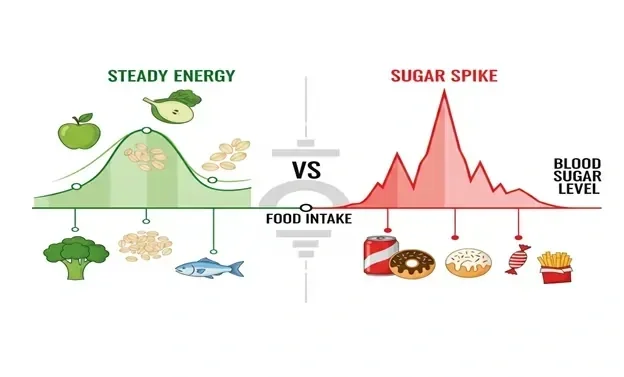Top 10 Nutrition Tips for Managing Diabetes Effectively
When it comes to managing diabetes, many people think it means giving up on delicious meals. But the truth is, you can enjoy a variety of tasty foods while still prioritizing your health. The key lies in making smarter food choices that help you maintain stable blood sugar levels and keep your energy up throughout the day. Here are ten nutrition tips given by expert nutritionist to help you navigate your meals while managing diabetes effectively.
Opt for Intelligent Carbohydrates
It’s true that carbohydrates impact blood sugar, but not all carbs are created equal. Instead of reaching for white bread, pastries, or those tempting sugary snacks, opt for whole grains like oats, quinoa, or brown rice. These healthier carbs release energy more gradually, helping you avoid those dreaded sugar spikes and crashes. Pairing carbohydrates with protein or healthy fats can also bolster your energy levels, keeping you satisfied longer. Think of carbs as fuel—make sure to choose the quality options for a smoother ride.
“Evidence also shows that diets with better carbohydrate quality (whole grains, lower added sugar) are linked to more favourable metabolic control; while diets high in added sugars are associated with worse HbA1c and lipid profiles among people with diabetes.”
Focus on Foods Rich in Fiber
Next up is fiber, which plays a superstar role in blood sugar management. Fiber slows digestion, preventing those quick rises in blood sugar that can leave you feeling drained. Foods rich in soluble fiber, such as beans, lentils, fruits, vegetables, nuts, and seeds, should be the focus of your diet. Not only does fiber help keep your blood sugar in check, but it also promotes good digestion, supports weight management, and helps maintain cholesterol levels. A simple rule to remember: fill half your plate with veggies at lunch and dinner.
Equalize Your Plate Using the Plate Method
This straightforward approach enables you to create balanced meals without fussing over complicated calculations. Imagine your plate divided into sections: half should be non-starchy vegetables like broccoli or peppers, one-quarter for lean proteins such as chicken or tofu, and a final quarter for healthy carbs. This method not only simplifies portion control but also helps you visualize and manage your intake without the stress of overthinking every single bite.
Add Lean Protein to Every Meal
Protein stabilizes blood sugar by slowing down digestion and enhancing satiety, making you feel fuller for longer. Go for options like chicken, fish, eggs, tofu, or legumes. Starting your day with a protein-packed breakfast, like a veggie omelet or Greek yogurt topped with berries, can set the tone for sustained energy throughout the morning.
Integrate Healthy Fats
Contrary to popular belief, not all fats are bad. Foods like avocados, nuts, seeds, and olive oil provide essential fatty acids that are beneficial for your heart and brain while also aiding in vitamin absorption. Together with carbohydrates, healthy fats can slow the absorption of sugar into your bloodstream. As you plan your meals, try drizzling some olive oil over your salad instead of using heavier dressings, or reach for almonds instead of chips when you need a snack.
Keep Yourself Hydrated with Intelligent Beverage Choices
Beverages high in sugar, such as sodas and energy drinks, can lead to spikes in blood sugar levels. While water is the best option for staying hydrated, you can add some variety by infusing it with ingredients like lemon, cucumber, or fresh herbs. Unsweetened herbal teas are another excellent alternative. If you consume coffee, try to minimize added sugars and creamers. Maintaining proper hydration aids in regulating blood sugar, supports digestion, and helps avoid fatigue. Strive to drink at least 6–8 glasses of water each day, adjusting the amount according to your activity levels.
Apply Portion Control
Even nutritious foods can lead to blood sugar increases if consumed in excessive quantities. Managing portion sizes is essential for achieving balanced meals. Opt for smaller plates, measure carbohydrate portions, and be mindful of your hunger signals. Eating attentively—without distractions like television—can help you recognize when you're satisfied and prevent overeating. Consistency is also important: having smaller, well-balanced meals throughout the day helps maintain steady energy levels and avoids extreme fluctuations in blood sugar.
Limit Processed and Sugary Foods
While indulging in your favorite treats from time to time is fine, it's important to minimize consumption of highly processed items, refined carbohydrates, and added sugars. These foods can lead to quick spikes in blood sugar, making it more challenging to manage levels. Instead, when you have a sweet craving, opt for whole fruits or naturally sweet snacks such as dates with nuts. When choosing packaged products, always check the labels for added sugars and sodium. Remember: the goal is not to overly restrict yourself, but to make mindful choices most of the time.
Plan and Prep Meals Ahead
Planning meals in advance can help you stay on track and reduce the likelihood of making impulsive food choices. When you prepare meals ahead of time, you ensure that you have balanced options readily available, decreasing the chance of turning to fast food or sugary, fatty snacks. Cook lean proteins in large quantities, chop up vegetables for quick salads, and keep healthy snacks like nuts or yogurt easily accessible. Meal prepping not only saves time but also aids in maintaining steady blood sugar throughout the week.
Don’t Skip Meals
Although it might seem trivial, skipping meals can lead to blood sugar levels dropping too low or spiking when you finally do eat. Eating regular, balanced meals helps maintain consistent energy levels and curtails cravings. Aim to consume something every 3–4 hours, pairing carbohydrates with protein and healthy fats. If your schedule is tight, have portable snacks like a handful of nuts, fruit, or protein bars on hand to prevent long intervals without food. Maintaining consistency is crucial for stabilizing blood sugar and promoting overall wellness.
Conclusion
Diet + Activity = Improved Diabetes Control
Managing diabetes isn’t about restriction — it’s about making smarter, sustainable choices that support your blood sugar, energy, and long-term wellbeing. By choosing whole foods, balanced meals, steady hydration, and consistent eating habits, you give your body the tools it needs to stay in control. But true diabetes management becomes even more effective when smart nutrition is paired with safe, structured physical activity.
At Movement Therapy EP, we specialise in helping people across Sydney and nearby suburbs build a lifestyle that works with their condition — not against it. Our expert Exercise Physiologists guide you step-by-step through evidence-based movement plans tailored specifically for diabetes, energy levels, weight goals, and daily routine.
If you’re ready to stabilise your blood sugar, boost your energy, and take charge of your health with confidence, now is the perfect time to begin.
Book an appointment with Movement Therapy EP today — Sydney’s trusted experts in diabetes-friendly exercise and lifestyle support.
FAQs
-
Foods rich in fibre, lean protein, healthy fats, and low-GI carbohydrates are best for managing diabetes. Options like whole grains, legumes, vegetables, nuts, seeds, avocado, fish, and berries help stabilise blood sugar and keep energy levels steady throughout the day.
-
Most diabetes experts recommend eating regular, balanced meals every 3–4 hours. Consistent eating helps prevent blood sugar spikes or drops. Using the Plate Method and pairing carbs with protein or healthy fats can help maintain stable glucose levels.
-
Yes. Regular physical activity improves insulin sensitivity and helps your body use glucose more effectively. Working with an Exercise Physiologist — such as at Movement Therapy EP in Sydney — can help you follow safe, personalised exercise routines that support diabetes management.
-
The best approach is to use the Plate Method, choose low-GI carbs, prioritise high-fibre foods, and prepare meals ahead of time. Meal prepping reduces unhealthy food choices and helps keep blood sugar stable throughout the week.



